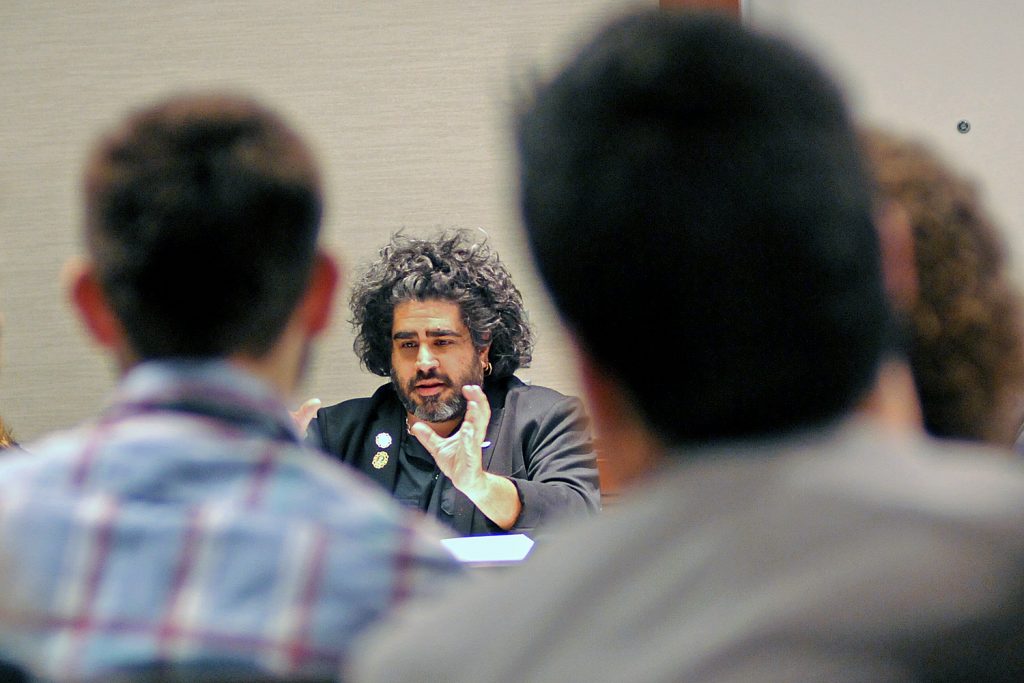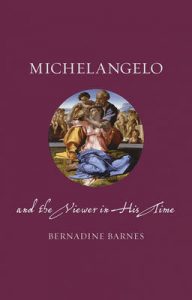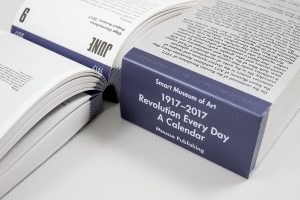CAA News Today
CAA Receives Major Anonymous Gift to Support Art History Faculty and Students
posted by CAA — August 08, 2018
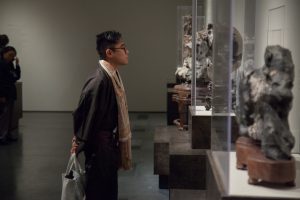
2018 CAA Annual Conference. Image: Rafael Cardenas
We are pleased to announce CAA has received a major anonymous gift of $1 million to fund travel for art history faculty and their students to special exhibitions related to their classwork. The gift will establish the Fund for Travel to Special Exhibitions, a new program to be administered and juried by CAA.
“This incredibly generous gift will not only support art history scholars and students for years to come, it is a powerful message to the visual arts field that their work is as important as ever,” said Hunter O’Hanian, CAA’s executive director. “The new Fund also reinforces CAA as the preeminent organization supporting and advancing professionals in the visual arts and design.”
Groundbreaking in its scope, the Fund for Travel to Special Exhibitions is intended exclusively to enhance the first-hand knowledge of original works of art. The Fund will support travel, lodging, and admission for art history students and faculty in conjunction with special museum exhibitions in the United States and throughout the world. Awards will be made exclusively to support travel to exhibitions that directly correspond to the class content. However, exhibitions on all artists, periods, and areas of art history are eligible.
Awards of up to $10,000 will be granted on a per project basis by a jury formed by CAA to oversee the Fund for Travel to Special Exhibitions.
Applications will be accepted by CAA beginning in fall 2018. All application criteria and information will be listed on the CAA website.
News from the Art and Academic Worlds
posted by CAA — August 08, 2018
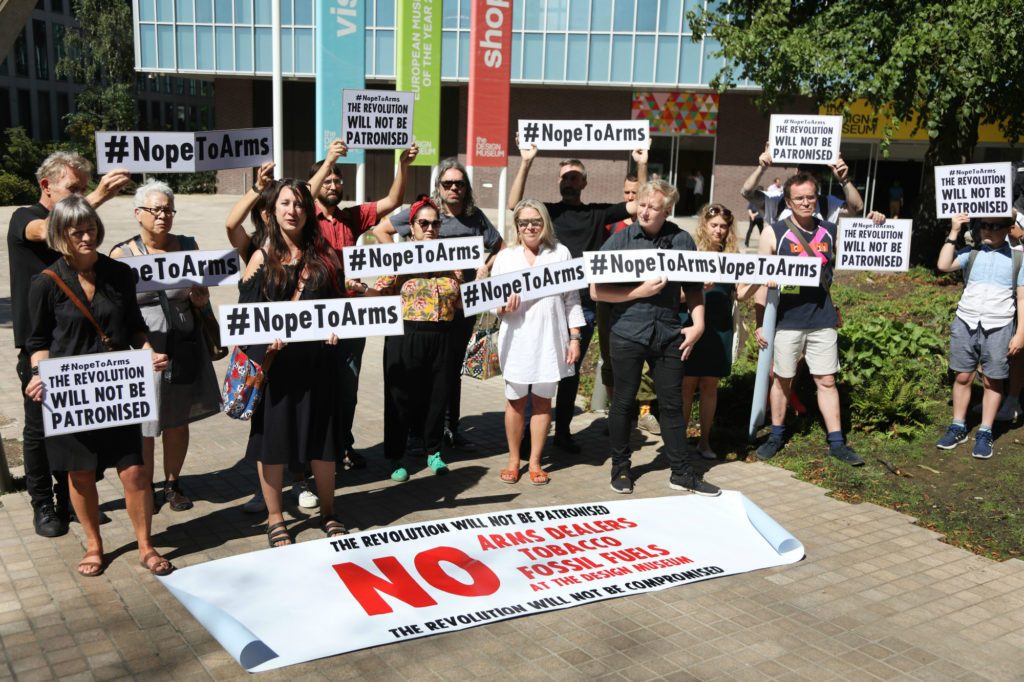
Artists removed their works from the Design Museum as a protest. Photo by Kristian Buus, via artnet News.
Artists Dramatically Remove Their Work From London’s Design Museum to Protest Its Decision to Host an Arms Dealer
Artists are criticizing the museum’s response to its decision to host an event for a defense company. (artnet News)
Walker Art Center Announces Formation of New Indigenous Public Art Selection Committee
The news comes in light of a healing process following the installation and subsequent removal of Sam Durant’s sculpture Scaffold. (Star Tribune)
Art Schools Aren’t Doing So Badly While Other Colleges Struggle
While art and design schools aren’t immune, they aren’t coming under as much pressure as other colleges. (Bloomberg)
How a Little-Known Nonprofit Is Bringing Social Practice Art to New York’s Most Elite Museums—and Beyond
The Kenan Trust has given $6 million to promote art that furthers social justice, from the Met and the Guggenheim to the Laundromat Project. (artnet News)
The New BBC TV Series and What We Mean When We Say “Civilization”
PBS has now finished airing its series Civilizations, a nine-part look at the global history of art. (Hyperallergic)
The Art of Learning: Why Art History Might Be the Most Important Subject You Could Study Today
“I cannot think of any discipline more inherently interdisciplinary than art history.” (Salon)
Submit a Proposal for a Professional Development Workshop at CAA 2019 – DEADLINE EXTENDED!
posted by CAA — August 06, 2018
The CAA 2019 Annual Conference will offer up to thirty 60-minute art-making and Professional Development Workshops, which will be free and open to the public.
This summer, we surveyed our members to determine what kinds of Professional Development Workshops would be most helpful. Members shared that there was the highest need for workshops on grant writing; finding grant funding and fellowship opportunities; pedagogy; diversity and inclusion; job searching and networking; publishing advice; online learning platforms and technology; financial planning, strategies and negotiation. Workshops related to exploring art making and design are also desired.
Twenty of these workshops are generously supported by the Emily Hall Tremaine Foundation and will be led by MFA students and/or entry-level, part-time faculty local to the 2019 Annual Conference in New York. Workshop leaders will receive a complimentary one-year CAA membership, a full Annual Conference registration for 2019, and a small stipend. (Please note that there may be only one leader for each Tremaine Foundation-supported workshop.) We have extended the deadline until September 14, 2018, for Tremaine workshop proposals. Click here to submit.
In addition to those funded by the Tremaine Foundation, CAA will offer additional Professional Development Workshops. Workshop leaders will receive a full Annual Conference registration for 2019 and a small stipend. (Please note that there may be only one leader for each workshop.) These workshop leaders do not need to be from the local New York area. The proposal deadline for these workshops closed August 31, 2018.
Proposals will be selected by the Annual Conference Committee.
While workshops will be scheduled concurrently with conference sessions, we will do our best not to schedule with overlapping content.
New in caa.reviews
posted by CAA — August 03, 2018
Nicoletta Rousseva writes about Revolution Every Day: A Calendar, edited by Robert Bird, Christina Kiaer, and Zachary Cahill. Read the full review at caa.reviews.
James P. Anno reviews Michelangelo and the Viewer in His Time by Bernadine Barnes. Read the full review at caa.reviews.
CWA Picks for August 2018
posted by CAA — August 02, 2018
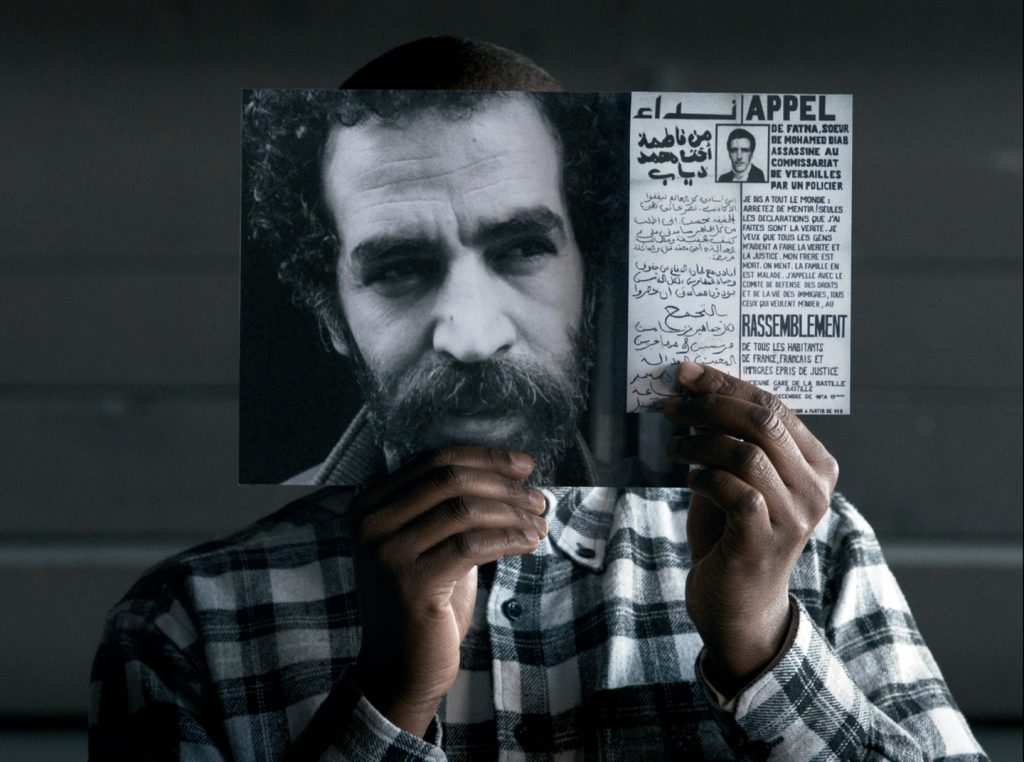
Bouchra Khalili, The Tempest Society, 2017. Video. © Bouchra Khalili / ADAGP, Paris, 2018. Courtesy Bouchra Khalili and Galerie Polaris, Paris.
CAA’s Committee on Women in the Arts selects the best in feminist art and scholarship to share with CAA members on a monthly basis. See the picks for August below.
Pussy, King of the Pirates
July 14–September 8, 2018
Maccarone Gallery
300 S. Mission Road
Los Angeles, CA
By now the summer gallery group show is a well-worn and fairly stale exhibitionary trope. Guest curators are brought in to align artworks from the gallery’s roster of artists alongside a few choice loans. Pussy, King of the Pirates is perhaps the most vibrant example of the summer group show—one that attempts to put politics into coordination with a summer holiday.
The show, which gets its moniker from the Kathy Acker novel of the same name, is a collection of twenty “non-male” artists. That distinction is important as not all the artists share in an embrace of “womanhood” (whatever that may be), but each interrogates feminism’s expansive boundaries from their own conceptual and material practices. Highlights include the sublime, small, dark Monica Majoli painting of an ex-girlfriend (Black Mirror (Judie), 2012) and Laura Schnitger’s spangled pantyhose processional totems. Eleanor Antin’s sculptural portraits are brilliant, evocative, and alive; while Alison Saar’s sculptures hold the stoic center of the installation.
This vacation, for all its noise, is a respite for the politically engaged—a life-giving show full of possibility.
Banu Cennetoğlu
June 29–August 26, 2018
Chisenhale Gallery
64 Chisenhale Road
London E3 5QZ
If you visited Kassel during documenta 14, you will remember the insightful warning “Being Safe is Scary” on the Fridericianum by the Istanbul-based artist Banu Cennetoğlu. The quote comes from the posthumously published diary of a female Kurdish fighter that was the subject of the artist’s other documenta—this one shown in Athens—that better captured her interest in collecting, classifying, archiving and the politics of memory and knowledge. Idiosyncratically summing up the major concerns of her practice, along with their underlying obsession with “speaking for the others,” as recently described by the artist, her current exhibition at the Chisenhale Gallery comprises Cennetoğlu’s first commission by a UK Institution in the form of a major two-fold solo exhibition.
For her commission, Cennetoğlu has produced a new moving-image installation consisting of the artist’s own archive of digital images and videos sourced from various devices, such as mobile phones, computers, cameras and external hard drives. The work presents a continuous stream of unedited content, ordered in a chronological format from 2006 to 2018, and lasting 128 hours and 22 minutes. It is presented as a different six hour-long file each time the gallery is open. Tracing over a decade of personal, social and political change from the banality of life’s inconspicuous and conspicuous moments to salient moments of recent history, it comprises an important archive of our times marked by linearity and circularity that captures both the intersection of self and history as well the changes in image production and circulation. In conjunction with her installation Cennetoğlu also facilitated the distribution of The List in The Guardian newspaper on June 20, 2018, World Refugee Day. Compiled each year by UNITED for Intercultural Action, The List traces information relating to the deaths of 34,361 refugees and migrants who have lost their lives within, or on the borders of Europe since 1993. Since 2007, in collaboration with art workers and institutions, Cennetoğlu has facilitated updated versions of The List using public spaces such as billboards, transport networks, and newspapers. As a whole the exhibition thus effectively shows the impossibility of a complete separation of one’s own life from that of the other’s, and this drives Cennetoglu’s artistic explorations and its politics.
Huma Bhabha: We Come in Peace
April 17–October 28, 2018
Metropolitan Museum of Art
1000 Fifth Avenue
New York, NY
On the roof of the Metropolitan Museum of Art two monumental figures face off. One, a janus-faced twelve-foot-tall alien, and the other, one of the artist’s signature Benaam—a prostrate, crumpled figure which she often uses to stand in for the nameless dead in the Iraq and Afghanistan wars. Although the works look like they’re made from plastic, Styrofoam, and earth, they are cast in bronze to withstand the elements.
Other artists have approached the Met’s rooftop with bombastic aplomb, topping its paving stones with flashy trinkets (Jeff Koons) or complex structures (Doug and Mike Starn). Bhabha is spare, restrained, and as a result leaves the space—which otherwise serves as a picturesque lookout onto Central Park—charged with the lingering inhumanity of the United States’s protracted international incursions.
Walking around and between the figures one feels caught in a crossfire—between recognition and strangeness, life and death, possibility, and certitude.
Laure Prouvost: Ring, Sing and Drink for Trespassing
June 22–September 9, 2018
Palais de Tokyo
13, avenue du Président Wilson
Paris
The French, and now Antwerp-based, winner of the 2013 Turner Prize, Laure Prouvost has continued to do what she was originally distinguished for: the awesome, often seductive, complexity with which she enjoins objects, multimedia images, and sound with language, in surreal combinations of life- and art-inspired story telling, often directly addressing the viewer. Prouvost’s work adopts the form of independent stories where action mixes with reality in immersive installations that invite escapism through an evocative combination of films, sculptures, paintings, tapestries, and performances. Imaginative, sensuous and full of humor, her work examines the relationships between language, image and perception, trapping the visitors in situations of pleasure, doubt and incomprehension evincing a delectably intense—both intellectual and multisensorial—wonder underpinned from a radically feminine excess.
For this typically exuberant return home, her first solo show in a Parisian institution, Prouvost responds to global warming and transforms Palais de Tokyo into a space where nature is purported to have taken over from humanity. Inviting both intimate and expansive exploration and a polyvalent meeting of paradise and wasteland, the exhibition begins through a curved corridor covered in woven tapestries that lures the viewer into an unknown territory. This eventually evolves into a metallic network of manufactured objects, interwoven with branches, car mirrors, her signature raspberries, collages, newspaper clips as well as vases in the shapes of bottoms. Flowers indicate that nature has annexed the building’s architecture and the outside world has broken in. At the center of the exhibition, a large fountain of breasts is waiting to feed the viewer, a respite where one can reflect after discovering the atypical panoramas conceived by the artist. There, a new video reflexively incorporates some of the physical elements present in the exhibition, complementing the multifaceted confounding that the rest of her works achieve, and inviting the viewer to question her/his preconceptions of the world at large.
Bouchra Khalili: Blackboard
June 5–September 23, 2018
Jeu de Paume
1, place de la Concorde
75008 Paris
Bringing a large selection of her work from the past ten years, this extensive survey introduces the radically experimental multimedia and documentary practice of French-Moroccan artist Bouchra Khalili (born in Casablanca, 1975 and now living in Berlin). Khalili is known for films, video installations, photographs and silkscreens that enable members of minorities to perform strategies of resistance against power, while systematically seeking for a new collective voice by articulating subjectivity and collective history.
The exhibition premiers Twenty-Two Hours, a new film that investigates Jean Genet’s commitment to the Black Panther Party, reflecting on the essential connection between poetry and collective emancipation, as well as The Tempest Society a work produced for documenta 14 in Athens, illuminating the artist’s long term reflection on radical equality and art as a civic platform. It also brings together older works that capture a variety of central topics underpinning her critical exploration of past and present, marked by all kinds of borders and their crossing, a critique of history and the present condition of civic society and the rescuing of all kinds of silenced voices. Among them stands out her look at globalized trade from the perspective of migrant laborers (The Seaman, 2012); displacement and forced journeys whether in the Mediterranean (The Mapping Journey Project, 2008-2011 and the “Constellation” series, 2011) or from the Caribbean to the US (as in the photographic series “Wet Feet,” 2012), as well as different modes of belonging (the
“Speeches”, 2012-3), and in the multimedia installation Foreign Office, 2015, unexpected contexts of liberation movements, such as Algiers.
Pia Camil: Telón de Boca
August 11, 2018–
Museo Universitario del Chopo
Dr. Enrique González Martínez no. 10
Mexico City, Mexico
For years now Mexican artist Pia Camil has employed used t-shirts as a primary material in her practice—elegantly tying together nostalgia, global capital, and architectural intervention. For her installation at the Dallas Museum of Contemporary Art (Bara Bara Bara, 2017) the shirts were sewn together into large quilts and floated from the museum’s cavernous ceiling Viewers could poke their heads through these colorful “clouds,” effectively separating their heads from their bodies, and becoming the inhabitants of a surreal topography.
In this installation Camil has sewn together hundreds of black concert t-shirts, obtained through a sequence of events at the museum and the nearby tianguis. Markets, formal and informal, thus structure the creation and display of the piece—as value is exchanged both through the activity of trade and the transformation of the humble t-shirt into a large-scale work of art. That the t-shirts “speak” their own message (the “mouth” of the exhibition’s title) is a necessary complication to the artist’s gesture. In this way the work exists somewhere, as per the exhibition’s press release, between “the fetish, the ritual, and the everyday.”
2018 Professional Development Fellowships for Graduate Students Now Open
posted by CAA — August 01, 2018
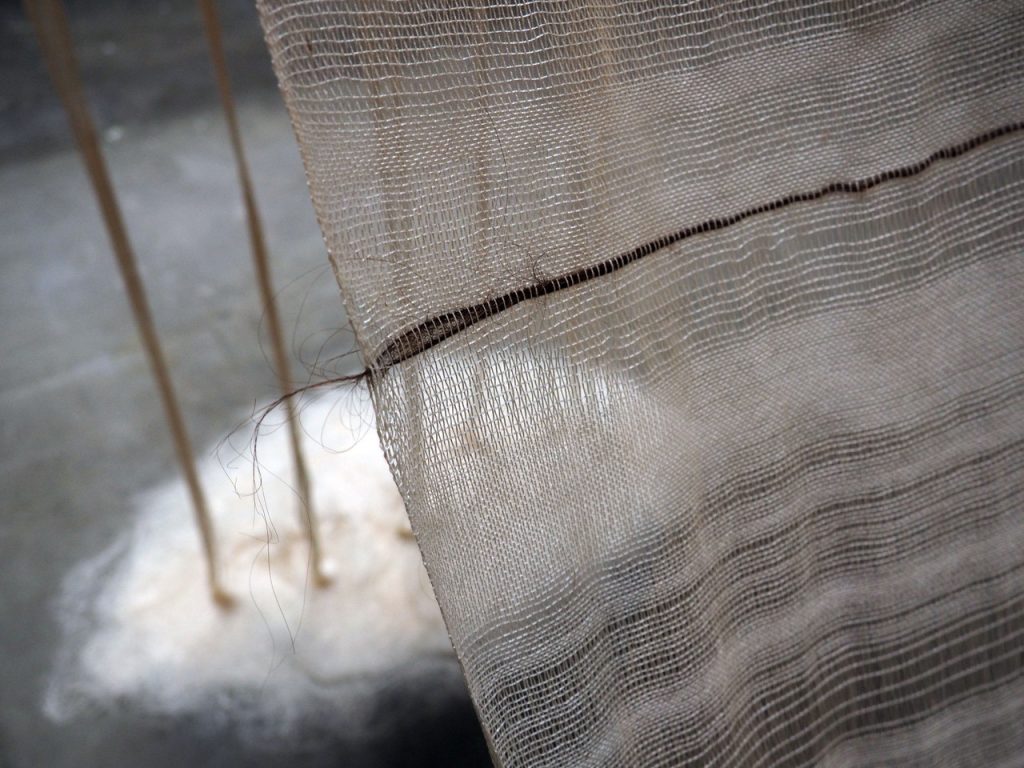
Brenna K. Murphy, Grief Work (Shroud). Detail. Cotton yarn and artist’s hair, 100 ft x 40 in. 2017 Professional Development Fellow in Visual Art.
The Professional Development Fellowships program supports promising artists, designers, craftspersons, historians, curators, and critics who are enrolled in MFA, PhD, and other terminal degree programs. Fellows are honored with $10,000 unrestricted grants to help them with various aspects of their work.
One award will be presented to a practitioner—an artist, designer, and/or craftsperson—and one award will be presented to an art, architecture, and/or design historian, curator, or critic. Fellows also receive a free, one-year CAA membership and complimentary registration to the Annual Conference. Honorable mentions, given at the discretion of the jury, also earn a free one-year CAA membership and complimentary conference registration.
CAA initiated its fellowship program in 1993 to help student artists and art historians bridge the gap between their graduate studies and professional careers. Past recipients include artists and thinkers such as Marin Sarve-Tarr (2015), Maggie Cao (2014), La Toya Ruby Frasier (2006), Risë Wilson (2002), Chitra Ganesh (2001), Miguel Luciano (2000), Miwon Kwon (1996), and Blake Stimson (1995), among many others.
ARE YOU ELIGIBLE?
CAA seeks applications from students who are current members; will receive their MFA or PhD degree in the calendar year 2019, following the year of application (2018 for the current fellowship cycle); and have outstanding capabilities and demonstrate distinction in their contribution to art history and the visual arts.
A jury of artists, curators, and other professionals will review all applications in fall 2018 and announce the recipients in January 2019.
HOW TO APPLY
DEADLINES
PhD Fellowship: October 1, 2018
MFA Fellowship: November 16, 2018
CONTACT
For more information about the CAA fellowship program, please contact Aakash Suchak, grants and special programs manager, at asuchak@collegeart.org.
News from the Art and Academic Worlds
posted by CAA — August 01, 2018
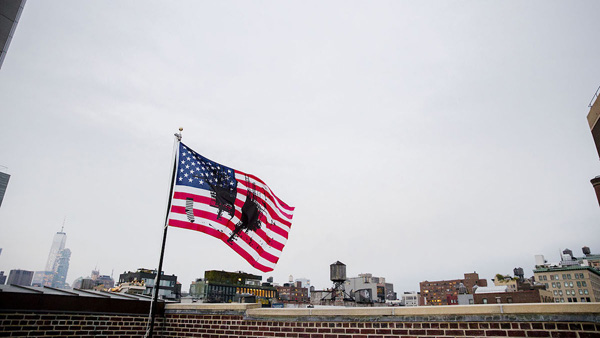
Josephine Meckseper, Untitled (Flag 2), 2017. Photo by Guillaume Ziccarelli. Courtesy of Creative Time via Artsy.
The Rise of Artistic Censorship on College Campuses Should Worry the American Public
Sarah McLaughlin from Foundation for Individual Rights in Education (FIRE) writes on the recent controversy surrounding artist Josephine Meckseper’s artwork at University of Kansas, and the trend of censorship on college campuses at large. (Artsy)
‘The Reaction Has Been Overwhelming’: Susan Unterberg Comes Forward as a Major Anonymous Patron of Female Artists
Since 1996 the Anonymous Was a Woman award has provided $5.5 million in grants to female artists aged over 40. (artnet News)
Archiving While Black
“In more than one instance, I have looked up from my research to see paintings of white men famous for committing heinous acts against indigenous communities, or racist artifacts displayed proudly as if devoid of the context in which they were produced.” (Chronicle of Higher Ed)
Debt-Ridden Students Claim For-Profit Art Institutes Defrauded Them With Predatory Lending Practices
As the Art Institutes closes 18 campuses, students claim to have been defrauded by high tuition costs, interest rates, and few career prospects. (artnet News)
In Rihanna Photoshoot for Vogue Paris, Juergen Teller Cribs Imagery from Mickalene Thomas
The two artists are both represented by Lehmann Maupin and listed side-by-side on the gallery’s website. (Hyperallergic)
Visiting the Museum: Learning Resources
Helpful tools to help students think more critically about art museums and their relation to the study and practice of art history. (Art History Teaching Resources)



